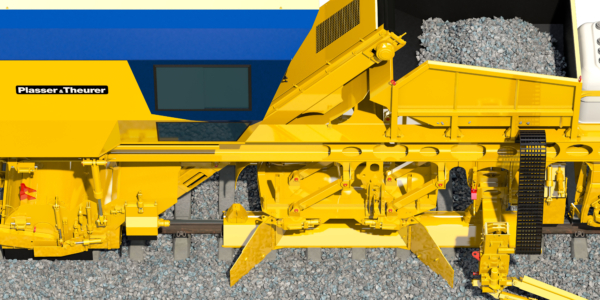 today 139
today 139
Our machines for ballast profiling are optimally suited to distributing and regulating track ballast. This includes ploughing ballast shoulders, track benches, and ballast crowns as well as various sweeping operations. It also entails collecting, storing, and re-placing ballast.
The new ballast regulating machines in the Plasser BallastMaster series can be set up variably. With their wide performance range, they are compatible with a great number of track and turnout tamping machines. The only way to reduce the costs of modern track maintenance is through an optimum combination of tamping, stabilising, and profiling.
During the development stage, special attention was paid to cost effectiveness and efficiency for operating companies. The machine design and the combination of the work units are based on the defined requirement profile.
The smallest 2-axle version is also suitable for line category C2 (20 t axle load). The largest 4-axle version has two driver’s cabs with continuous panelling and can even be operated with our E³ drive system.
The new ballast regulating machines use ballast sparingly and store surplus ballast to replace it where it is lacking. All machines in the new series are equipped with an integrated hopper to enable shifting of ballast as well as storage of small quantities of surplus ballast. The spectrum ranges from storage volumes of approx. 5 m³ to machines with hoppers of 7.5 m³ and up to 10 m³.
The two-part shoulder ploughs can be adapted to any ballast shoulder without infringing the clearance gauge of an adjacent track - even when setting up the machine. The ballast collected by the shoulder ploughs is picked up and distributed in the area of the ballast crown. The guide plates and adjustable plough blades of the centre plough precisely control the respective direction of the flow of ballast. As a result, the tamping area is well filled with ballast. The next step is to have the sweeping unit clear the sleepers of any remaining ballast stones. This surplus ballast is unloaded either on the side of the track or, for greater cost efficiency, carried on a conveyor belt to a storage hopper.

The newly developed adjustable brush shaft enables maintenance of all sleeper types. In turnouts, wooden sleepers and concrete sleepers require a uniform brush, whereas concrete sleepers on plain line tracks call for a graded brush shaft. For special sleepers, intermediate positions are also necessary. Until now, the entire brush shafts had to be changed depending on the application scenario, which was a labour-intensive and time-consuming process. With the new sweeper brush, this is no longer necessary, and there is no need to carry a replacement brush. The brush shaft adjusts continuously.
Until now, the sweeping units could distribute the collected ballast either into the hopper or onto the shoulders. With the new generation, it is possible to select flexible distribution ratios: one third of the ballast into the hopper and two thirds onto the shoulders or vice versa. Of course, it is still possible to transfer the entire ballast into the hopper.
The steep conveyor belt to the hopper has also been improved. The optimised inclination and straight guide make it easier to convey ballast into the hopper. Various measures, such as better sealing and an optimised connection to the brush housing, reduce dust development.
Thanks to the hopper, the pre-deposited ballast is optimally distributed before tamping, which makes the use of ballast much more cost efficient. The precise ballast distribution of our ballast regulating machines has a positive effect on the work result and the stability of the track geometry straight away. An optimal maintenance result can only be achieved if the amount of ballast placed on each metre of track is adapted to the requirements of the track lifting performed by the tamping machine.
Four adjustable ballast chutes allow the tamping zones to be flexibly and selectively ballasted with the stored ballast at any time. The arrangement of the chutes in front of the centre plough ensures the technologically correct work sequence. Placing ballast on the shoulders is also possible directly from the hopper.
The spacious work cabs of the ballast regulating machines have also been further optimised. The operators’ view of the track and the ploughs from the ergonomically designed operator's desks have been improved. This facilitates the work of the machine operators and increases quality and speed.
The hydraulic components and the engine are more easily accessible via the servicing platforms on both sides of the drive unit. On new machines, the engine has been rotated by 180° compared to where it was installed on older models. This simplifies access for servicing purposes and reduces noise in the cab.
The right technology is crucial to achieving the best technical and commercial results: